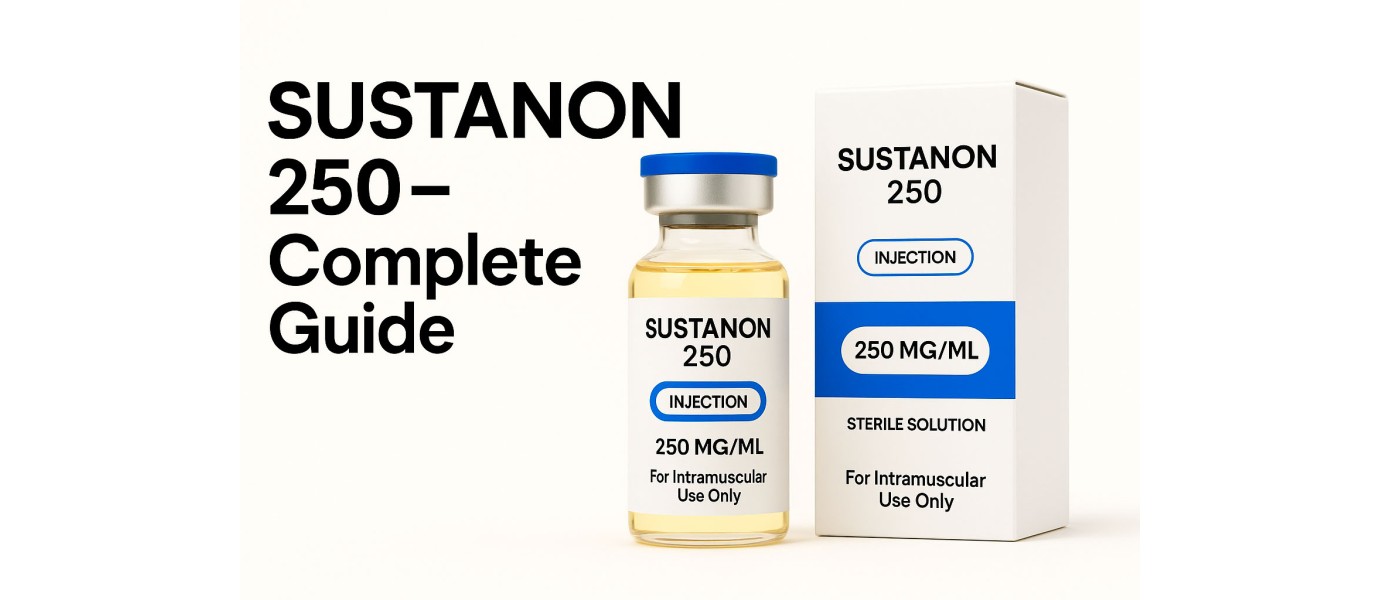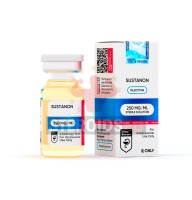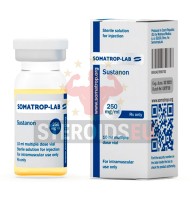Sustanon 250 — Complete Guide
Sustanon 250 is a four-ester testosterone blend designed to provide both rapid onset and sustained release. This guide covers composition, pharmacokinetics, benefits, dosing logic, injection schedules, cycles, PCT timing, side effects, lab monitoring, comparisons with single esters, and legal considerations in Europe & the UK. Educational content — not medical advice.
What is Sustanon 250?
Sustanon 250 is a multi-ester testosterone formulation intended to combine the quick onset of short esters with the sustained serum levels of longer esters. It has been used in medical hypogonadism and is also discussed in performance contexts.
- Prescription-only androgen therapy under physician supervision.
- Blend engineered for both rapid rise and extended coverage.
- Serum profile can be less predictable than single-ester options.
Looking for Sustanon 250?
Check our EU catalog for Sustanon 250 — fair prices, discreet packaging, guaranteed delivery.
Composition (4 esters & doses)
| Component (per 1 mL) | Amount | Role in profile |
|---|---|---|
| Testosterone Propionate | 30 mg | Fast onset; early peaks |
| Testosterone Phenylpropionate | 60 mg | Short/medium; bridges early phase |
| Testosterone Isocaproate | 60 mg | Medium; stabilizes mid-interval |
| Testosterone Decanoate | 100 mg | Long; sustains levels over days–weeks |
| Total Testosterone | 250 mg | Blend of rapid + sustained release |
Release Profile & Half-Lives
Each ester has its own approximate half-life and contributes to the composite curve:
- Propionate: ~2 days
- Phenylpropionate: ~3–4 days
- Isocaproate: ~4–6 days
- Decanoate: ~7–10+ days
How It Works (Mechanism)
After injection, esters hydrolyze to release bioactive testosterone, which binds the androgen receptor (AR), modulating gene transcription involved in muscle protein synthesis, erythropoiesis, bone density, libido, and mood. Peripheral conversion to DHT and estradiol affects tissue-specific outcomes (skin/scalp/prostate; bone/cardiometabolic).
Benefits & Expected Results
- Combined profile: quick onset plus sustained exposure without daily injections.
- Strength & lean mass: with structured training and diet.
- Recovery: improved training tolerance; reduced DOMS.
- Quality of life (in hypogonadism): potential improvements under medical care.
Side Effects & Risks
Risk is dose/exposure-dependent and similar to single-ester testosterone, with blend-specific nuances.
Estrogen-related
- Water retention, gynecomastia, mood lability when estradiol rises.
- Use aromatase inhibitors only when indicated; avoid over-suppression.
Androgenic
- Acne, seborrhea, androgenic alopecia predisposition; LUTS/prostate symptoms in susceptible men.
Cardiometabolic
- ↑ hematocrit/hemoglobin (polycythemia risk), ↓ HDL (sometimes ↑ LDL), BP changes.
Other
- Injection-site reactions; sterile technique is essential.
- Not classically hepatotoxic; caution with oral AAS or liver disease.
Monitoring: Labs & Health Checks
Sample consistently (e.g., trough or mid-interval) to compare apples-to-apples.
| Marker | Why it matters | Typical cadence |
|---|---|---|
| Total & Free Testosterone | Exposure check; correlate with symptoms | Baseline; 6–8 weeks after changes; then every 3–6 months |
| Estradiol (E2, sensitive) | Edema, mood, gynecomastia risk; bone health | With T checks; especially if symptomatic |
| Hematocrit/Hemoglobin | Polycythemia risk; viscosity/BP | Baseline; 8–12 weeks; then 3–6 months |
| Lipids (HDL/LDL/TG) | Cardiometabolic risk | Baseline; 3–6 months |
| Liver enzymes (ALT/AST) | Especially if orals/alcohol/liver disease | Baseline; 3–6 months |
| PSA, Blood pressure | Prostate screening; hypertension risk | Per guideline; home/clinic checks regularly |
Dosage (medical context)
Physician-directed, individualized dosing only. Labels may allow longer intervals, but many clinicians titrate to symptom relief and stable labs with shorter spacing.
- Initiation: conservative dose; reassess at 6–8 weeks.
- Titration: aim for the lowest effective exposure with acceptable labs and symptom control.
- Technique: deep IM under aseptic conditions.
Injection Schedules (TRT & performance)
- TRT practice: weekly (q7d) or every 10 days (q10d) often yields smoother levels than q14–21d.
- Split strategy: some divide the weekly dose into 2 injections (e.g., q3–4d) to minimize peaks/troughs.
- Performance contexts: weekly or twice-weekly to maintain steadier exposure during cycles.
Cycles & Stacks
Educational examples only — risks rise with dose/stacking. Medical supervision and labs are essential.
Beginner
- Sustanon 250: 250–300 mg per week
- Length: 8–10 weeks
- PCT required afterward
Intermediate Bulking
- Sustanon 250: 500 mg per week
- Dianabol: 20–30 mg/day (first 4–6 weeks)
- Optional: Nandrolone Decanoate 300–400 mg/week
- Length: 10–12 weeks
Cutting
- Sustanon 250: 300–400 mg per week
- Winstrol: 30–50 mg/day or 50 mg EOD
- Anavar: 30–40 mg/day
- Length: 8–10 weeks
Advanced Stack
- Sustanon 250: 500–750 mg per week
- Trenbolone Enanthate: 300–400 mg/week
- Masteron: 300 mg/week
- Length: 10–12 weeks
Post Cycle Therapy (PCT timing)
Because Sustanon contains long esters (e.g., decanoate), residual levels linger. Many protocols time PCT to begin when exogenous T declines sufficiently:
- Common window: ~14–21 days after the final injection (individualized by labs/symptoms).
- Typical elements: HCG (short term), SERMs (clomiphene, tamoxifen) as directed by a clinician.
Sustanon vs Enanthate/Cypionate/Propionate/Undecanoate
| Option | Profile | Injection frequency | Pros | Cons |
|---|---|---|---|---|
| Sustanon 250 (blend) | Short + medium + long esters | Weekly or split weekly | Fast onset + sustained exposure | Less predictable; harder to fine-tune |
| Enanthate | Medium-long | 1–2× per week | Stable, predictable | Slower onset vs blends/short esters |
| Cypionate | Medium-long | 1–2× per week | Similar to Enanthate | Minor practical differences |
| Propionate | Short | Every other day | Fastest adjustability | Frequent injections |
| Undecanoate (IM) | Very long | Every 4–10 weeks (per protocol) | Infrequent injections | Very slow to adjust; strict monitoring |
FAQ (People Also Ask)
How often should I inject Sustanon 250?
Weekly or every 10 days is common to smooth peaks/troughs. Longer gaps often feel “spiky”.
Does Sustanon 250 cause less water retention?
Some report less retention than long single esters early on, but overall estrogen balance and dose matter more.
When should I start PCT after Sustanon?
Commonly ~14–21 days post last shot; individualize with labs and clinician guidance.
Is Sustanon 250 better than Enanthate?
Not universally. Sustanon blends convenience and onset, but single esters are often easier to fine-tune.
Is it liver toxic?
Injectable testosterone is not classically hepatotoxic. Monitor ALT/AST if using oral AAS or with liver risks.
How long can it be detected?
Metabolites from long esters may be traceable for weeks after cessation; follow federation anti-doping rules.
Mini Lab Glossary
- Total Testosterone: ~300–1000 ng/dL (10–35 nmol/L).
- Free Testosterone: ~5–25 ng/dL (150–750 pmol/L).
- Estradiol (E2, sensitive): Men ~10–40 pg/mL (40–150 pmol/L).
- Hematocrit (HCT): ~40–50%; >54% = elevated CV risk.
- Lipids: HDL >40 mg/dL; LDL <130 mg/dL (lab-dependent).
- Liver Enzymes (ALT/AST): Often normal <~40 U/L; persistent elevation needs evaluation.
- PSA: <4.0 ng/mL in many labs; trends matter.
Conclusion
Sustanon 250 offers a hybrid kinetic profile by combining short and long esters. Outcomes depend on measured dosing, consistent injection timing, routine labs, and thoughtful risk management under medical supervision.
If you plan to use testosterone under prescription, work with a qualified clinician and choose authentic, lab-tested products with discreet, tracked shipping across Europe.
Legal & Medical Notice
Testosterone is prescription-only across most EU countries and the UK. This content is educational and not medical advice. Always consult a qualified clinician, obtain regular laboratory monitoring, and comply with local laws.



Write a comment